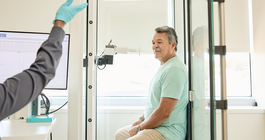
March 16, 2017
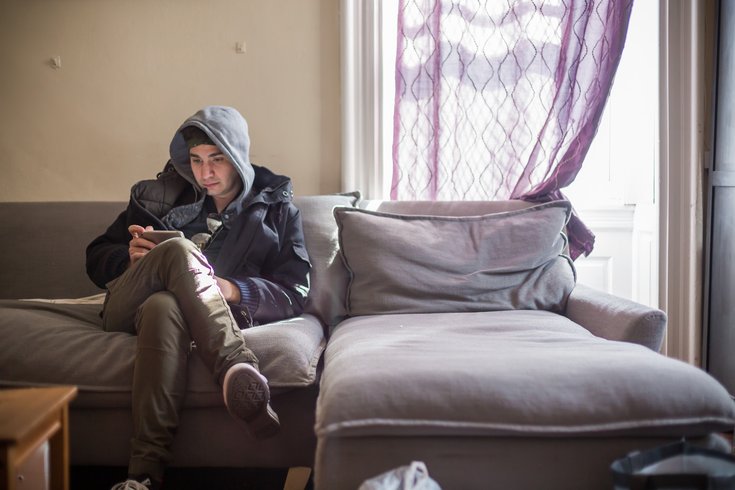 Thom Carroll/PhillyVoice
Thom Carroll/PhillyVoice
DJ uses his tablet in the living room on his first day as a resident of the LGBTQ Home for Hope. The home feels more like a college dorm than a homeless shelter.
It’s a Thursday night on North Hutchinson Street, a few blocks from a Save-A-Lot and Kicks USA, where kids are laughing and fooling around outside on an unusually warm night. The neighborhood, a mix of shopping plazas and burnt-out buildings, shows signs of decay along with promising new commerce. Two cats streak down the street – one dodges under a car and another climbs a fence. A few men sit on a nearby porch drinking from paper bags. A couple mingles close in the shadows of a streetlight, their faces obscured in the dark.
On this night in February, several dozen residents of the LGBTQ Home for Hope, a homeless shelter in the Fairhill neighborhood of North Philadelphia, are gathered in the common room to listen to rules about responding to fire alarms and doing chores. For some residents – they range in age from 19 to 67 – the home is their last chance for a roof over their heads after ejections from more mainstream shelters. For others, it is the first time they are clean and sober, trying to recover what they once had: a job, family and a place to live.
Truth is, the home feels more like a college dorm than a shelter. People come and go in colorful frocks and hoodies as a few folks laugh outside the main office. Others clean up after dinner; one man’s careful to hand sharp knives back to a staff member who places them under lock and key.
Instead of large rooms filled with cots and watchful eyes, personalized bedrooms are shared by roommates. The more-than-120-year-old gray stone building was a former rectory for the since-demolished St. Bonaventure Roman Catholic Church. It now sits on an acre of land with a market value of about $500,000, according to Northstar Manor Inc., which purchased the property three years ago for half that amount.
On each of the four floors, one finds familiar items, like shampoo, bath soap and moisturizer perched on side tables in each room. A bookshelf is filled with reading material. There’s a flat-screen TV in a sitting room with comfortable sofas. Someone works quietly on a laptop near a trio of cat bowls with no cats in sight on this night.
Everyone has chores to do and each resident is required to complete whatever therapy, rehab or education is needed to take the next step toward integration into society. They must leave in the morning and return in the evening like clockwork. And they must stay out of trouble.
After the rules meeting, some of the residents talked about their lives and the hope they have for the future they are rebuilding at the shelter. They talked candidly about the discrimination they face, and PhillyVoice agreed not to use their last names in this story.
The LGBTQ Home for Hope on North Hutchinson Street in Philadelphia. For some of the 37 residents the shelter is their last chance for a roof over their heads after ejections from more mainstream shelters. 
For some people, like Breanna, a 26-year-old black transgender woman, it’s not been easy. Without a high school diploma or GED, she is having a hard time finding a job, a requirement for residents at some point in their stay. Clutching her handbag close to her on a sofa in the living room, she admits she has trouble filling out applications. The questions on the website for employment at McDonald’s, for example, are hard for her to understand. She could use some help. And even then, she may not even get an interview.
“I didn’t have a place to live,” says Breanna, who survived on the streets before coming here. She says prostitution is one of the only ways transgender women without any formal education can earn money to eat. She’s not proud of some of the choices she had to make in her most desperate times.
“It’s hard getting an education,” says Breanna, whose been bullied for being transgender. She’s guarded for someone her age – but she tends to look at you deeply, intently when she talks about her experiences.
“It’s being around bad influences,” she says, looking away. “But what else are you gonna do?”
Breanna is actually one of the lucky ones.
Last year was the deadliest on record for transgender people in the United States. Of the LGBTQ people killed by violence, 67 percent were transgender or gender non-conforming, according to the National Coalition of Anti-Violence Programs. And more than half were transgender women of color.
In Philadelphia, several murders of transgender women have yet to be solved, like that of Stacey Blahnik and Maya Young. While the LGBT community has pressured the police department to investigate the crimes, there exists an animosity between much of the community and law enforcement, some say.
For young women like Breanna, finding peace and self-respect can be challenging, especially after doing things and associating with people who have damaged her. There’s a lot of hurt in her eyes. There’s also a lot of relearning going on at the shelter, much of which requires building up trust between residents and staff on a daily basis.
At Christmas, the residents sat down to a full meal together, something most of them haven’t been able to do in years. The shelter’s Facebook page regularly shares photos and videos of the goings-on, providing a glimpse inside where a Christmas tree was decorated in December and a Marilyn Monroe poster now hangs in the common room. These small touches have helped make the Home for Hope an actual home.
Student volunteers from Suffolk University in Boston are spending a week in Philadelphia as part of a program called 'Alternative Spring Break.' The students performed community service by cleaning at the LGBTQ Home for Hope on Monday, March 13, 2017.
Since opening its doors in September 2015, the goal has been to provide warmth, lights and a bed to residents for almost $10,000 a month in operating expenses.
“There aren’t a lot of places to go,” says Rene, a 52-year-old white lesbian. Rene has had a hard time since coming out when she was 14 and being called “d**e,” often by people in her own family. She says that many residents and staff at other shelters are homophobic, and use the same slur. She said she left rather leave than face the persistent abuse.
Before getting into hard drugs, Rene – who sports a buzz cut and tattoos – was a chef at one of the most successful casinos in Atlantic City. “This d**e used to make $120,000 a year,” she says. When she sees how people treat homeless people like her, as if they are inconvenienced to see them at the train station or outside Wawa, she wishes she could tell them just one thing. “We were one of you once,” she'd say. “We’re just having a bad time right now.”
Rene has a 32-year-old daughter she hasn’t seen in awhile. She, too, says she’s not proud of how she earned money to feed her drug habit and stay alive, like prostituting herself with men.
“Not the sex stuff,” she specifies, moving her hand to mimic masturbation. “Other stuff.”
Anthony, a 35-year-old gay man with blue hair, was a lot like Rene. He lived on Rittenhouse Square, hung with a fast crowd, and indulged in the city’s nightlife, hitting up gay bars and clubs at all hours. After Anthony’s boyfriend died, he unraveled, getting harder into drugs like crystal meth, which has hit the gay male community especially hard in the past decade.
According to the International AIDS Society, crystal meth use among gay and bisexual men is five-to-10-times more common than among the general population. The appeal is in its effects: stimulated energy, confidence and increased libido. As a long-acting stimulant, with street names like tina and crank, it can lead to promiscuity and unsafe sex and, ultimately, a greater risk for HIV and STD transmission.
“I never thought I would become a drug addict,” Anthony says. But when it happened, he lost everything, including his home and his friends. The good-time Charlies he would see from his Rittenhouse days would step past him on the street, not even recognizing him.
“I’ve OD’d about seven or eight times,” he says, mostly by taking opioids while he was in a methadone program. He says many people in the program are taking drugs on top of drugs – it’s a place to score. For him, getting off of methadone became key to beating his longtime addiction.
“I went back to the William Way,” Anthony says, and joined Alcoholics Anonymous meetings. He said it was the first time he felt like he could be honest about himself with no judging. A lot of similar rehab programs in Philly operate on religious principals that can make LGBTQ addicts feel like they are being judged differently. At the William Way LGBT Community Center, however, Anthony found friends who inspired him to get clean after years of relapsing. He’s since been volunteering on a regular basis at the center.
“I want to give back,” he says, an interesting pledge from someone who, by most accounts, has very little to give. But his time has become a very valuable commodity. He’s dedicated to showing up and putting in his hours. He also encourages other residents to join him from time to time.
Anthony hangs flyers up in the home about free events at the William Way. And he’s given several people the address so they can maybe volunteer, too. He says it’s been a way to work through his addiction and to get back on track.
“It’s a place you can go and talk about anything,” he says.
The William Way and the Home for Hope have both offered something new to residents like Anthony, places where they can create community in a healthy way, where they aren’t being judged for their sexual orientation or identity.
Deja Lynn Alverez, founder and executive director of the LGBTQ Home for Hope in Philadelphia, works in her office. “I’m able to have a dialogue with everyone in the house,” she says. “And we develop something – trust.”
The Home for Hope, which currently houses 37 residents with seven people on staff, offers an LGBTQ-centric approach to getting people off the streets and into programs that are ultimately helping them conquer addiction and trauma.
Deja Lynn Alvarez, founding director of the shelter, says one advantage of the unique atmosphere is getting to know residents on a personal level. “I’m able to have a dialogue with everyone in the house,” she says. “And we develop something – trust.”
Alverez works with CEO Sakina Dean – both women have backgrounds in social work. Initially called the Divine Light LGBTQ Wellness Center, Alvarez changed the name out of concern that any religious connotations might discourage prospective residents. Both women wanted to ensure that the most disenfranchised of the homeless population could be served.
It’s not uncommon for trans people, for example, to be turned away from other shelters in the city. Or, if admitted, asked to remove items of clothing (such as wigs and makeup) because their identity may not match their identification.
LGBTQ people, some residents say, are often harassed by fellow residents and staff at some of the city’s most prominent shelters. As such, Alvarez says Home for Hope offers something different, even from Morris House, a residential treatment facility for gender-variant people that’s been open since 2012. It may be the first time some of the residents have experienced being cared for, not despite who they are, but because of it.
One resident, a young black gay man who said he has been sexually abused for years, initially had problems building trust with Alvarez and the staff. He couldn’t accept that someone would want to do something kind for him without expecting sexual favors in return.
Alvarez admits that it can take a lot of time and therapy to reach each resident, and to ideally inspire him or her to take the next step toward becoming productive, healthy citizens who can do for themselves without the risk of lapsing into addiction and criminal behavior.
As a subsidiary of Divine Light, a group of addiction recovery homes in Philly, the definition of “recovery” at this home has been expanded to include the sorts of things that might impact someone who’s gay, lesbian, bisexual or transgender. But not all of the residents have recovery issues, of course. Often they’ve been abandoned by their families after coming out, and have had to survive on the streets since a young age.
There’s been solid support so far for the home, the first of its kind in the state specifically for LGBTQ people. The GoFundMe page has raised more than $45,000 to date. And local events, like a silent auction and raffle at Dirty Frank’s bar last month, bring in a few thousand more.
Alvarez says it’ll take a lot more to keep the doors open. Most grants rely on the home being able to pay full-time staff, which it does. There are also expenses for gas and water, trash removal and food. Some of the residents receive food stamps, a percentage of which can be used to purchase food for the entire community. Every little bit, she says, helps – including donations of necessities like toilet paper and cleaning supplies from the community.
Residents, from left to right, Sid, Josephine and Trey pose in the backyard of the Philadelphia LGBTQ Home for Hope.
For Trey, 28, and Sid, 34, the home has created meaningful friendships and mutual respect. The transgender men may come from seemingly different worlds – one from art school and the other from a tough neighborhood, respectively – but they have found camaraderie in their shared experiences.
Before coming to the home, Sid says he was “living in limbo” after being rejected by his family. The Latino community had trouble accepting his identity. He buddied up with Trey so they could both stay safe on the streets and in the system of shelters.
Trey, a former student and employee at University of the Arts, lost his job and ended up on the streets. To hear him talk about it, it sounds like a lifetime ago.
“I lost all of my friends,” says Trey, clutching a book and a backpack. A big reader, he likes to keep to himself when he’s not with Sid. They each want to become self-sufficient, but it means overcoming trauma.
Seemingly close enough to finish each other’s sentences, the men worry that things are only going to get more challenging as laws are passed making it harder for them to even use the bathroom.
“We just want to pee,” says Sid.
Kena, 26, says she’s experienced even more violence than usual lately, as if bullies are feeling especially emboldened.
“I had a bottle tossed at me,” says the 26-year-old black transgender woman. Wearing a hoodie, she slumps down on the couch. “It makes me feel terrible,” she says.
According to the Southern Poverty Law Center, incidents of violence toward LGBTQ people have actually been on the rise since the election. People have been verbally and physically attacked, and rainbow flags have been vandalized. The president’s turning back transgender protections for children recently has residents at the home bracing for what could happen to them.
Joey, 37, who also goes by Josephine, has had a harder than average time just trying to stay alive. Not only is she HIV-positive (most likely acquired after being gang-raped), she was beaten in the head and sustained traumatic brain injuries a few years ago. Growing up, Josephine says she always had learning disabilities.
During her almost four decades (almost two of which she’s been out as transgender) she estimates that she’s been arrested about 100 times and spent a year and three months in jail in New York City, where she’s from originally. A former Crip, her fellow gang members turned on her when they discovered she was transgender. They beat her and gang-raped her so badly that she had to be hospitalized.
Being in and out of courtrooms, jail cells and shelters with few if any job prospects leaves Josephine susceptible to prostitution. It’s a common story shared by many of the transgender women who make up a significant portion of residents here.
She left New York last year for Philly.
Admitting this is probably her last chance to turn things around, Josephine is learning how to live in a safe environment where she and other residents can build important life skills. The ultimate goal? Integrating with society.
For now, there is no limit to how long residents can stay at the home, though more guidelines are being put into place that could hasten things a bit depending on funding and space. Nor do residents have to meet any special requirements to be admitted. In fact, there is at least one heterosexual resident.
The good news is that since moving into the Home for Hope, Josephine has finally gotten her medications regulated to treat serious ongoing issues related to PTSD, borderline personality disorder and schizophrenia. She’s had to learn to control her temper, a side effect of a traumatic brain injury, and has successfully channeled some of her anger into protesting alongside groups like Black Lives Matters. She’s encouraged by the staff to get involved in activism as a way to express herself and interact in a positive way with others.
“I’m treatable,” she says. “But not curable.”
Fortunately, organizations like GALAEI (Alvarez formerly worked with the group’s Trans-Health Information Project), Philly Fight and the Mazzoni Center have all been instrumental in treating Josephine since she relocated to Philadelphia.
Josephine also credits the Home for Hope staff – saying aloud each of their names slowly and carefully for emphasis. There's a long list of people she wants to thank as if making an acceptance speech at the Oscars. She’s become very attached to them.
“But I’m not going to be here forever,” she says, adjusting her glittery off-the-shoulder top. “I need to learn how to transition.”
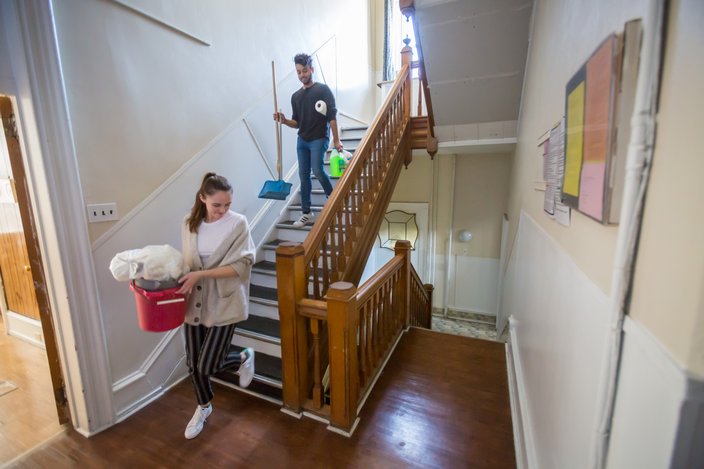 Thom Carroll/PhillyVoice
Thom Carroll/PhillyVoice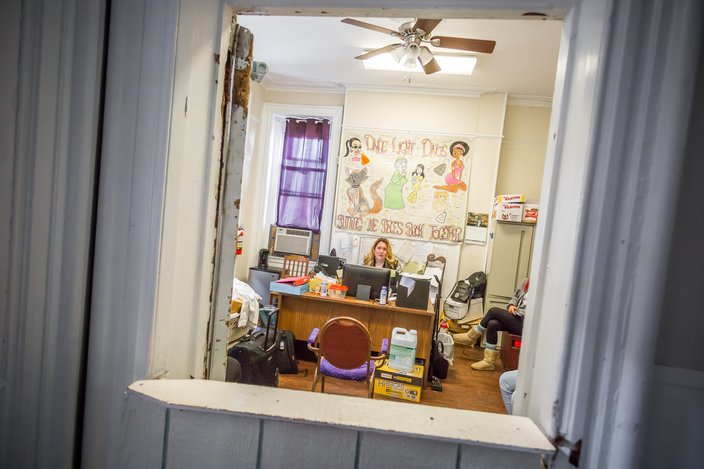 Thom Carroll/PhillyVoice
Thom Carroll/PhillyVoice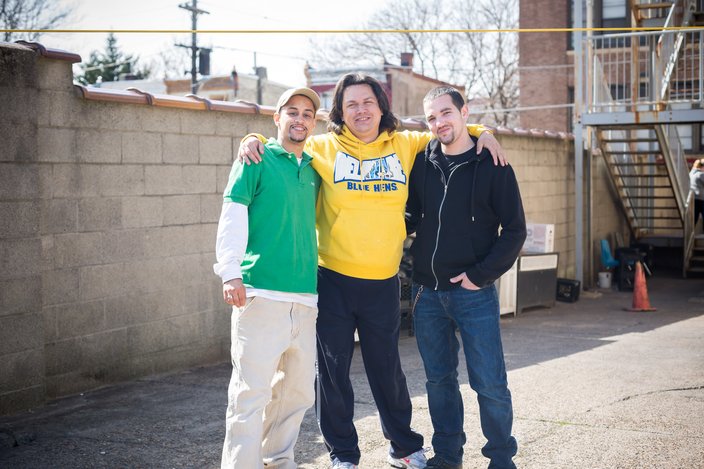 Thom Carroll/PhillyVoice
Thom Carroll/PhillyVoice